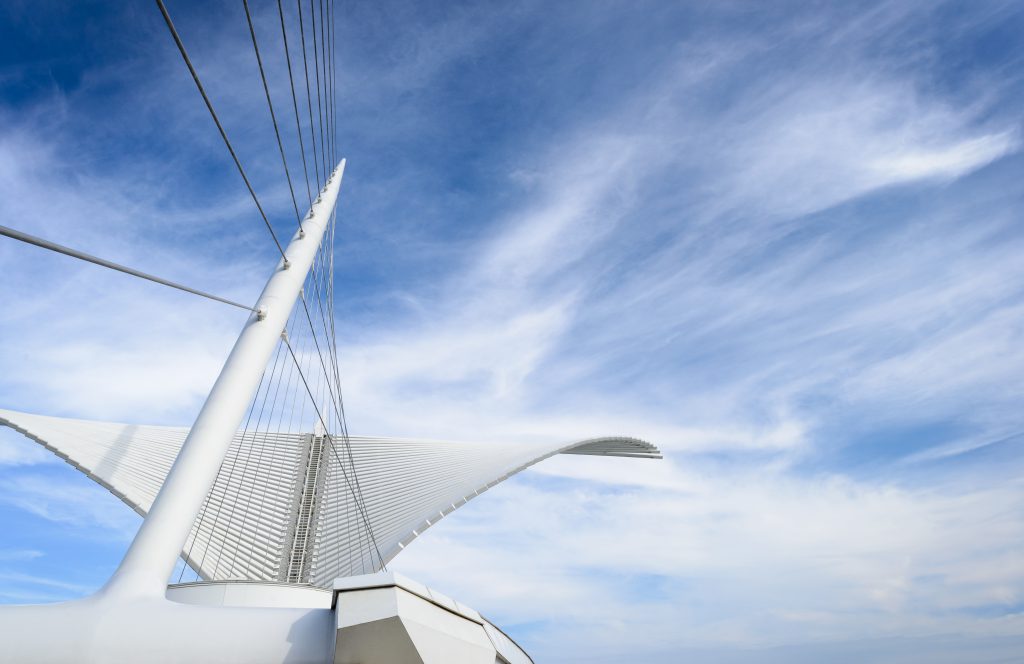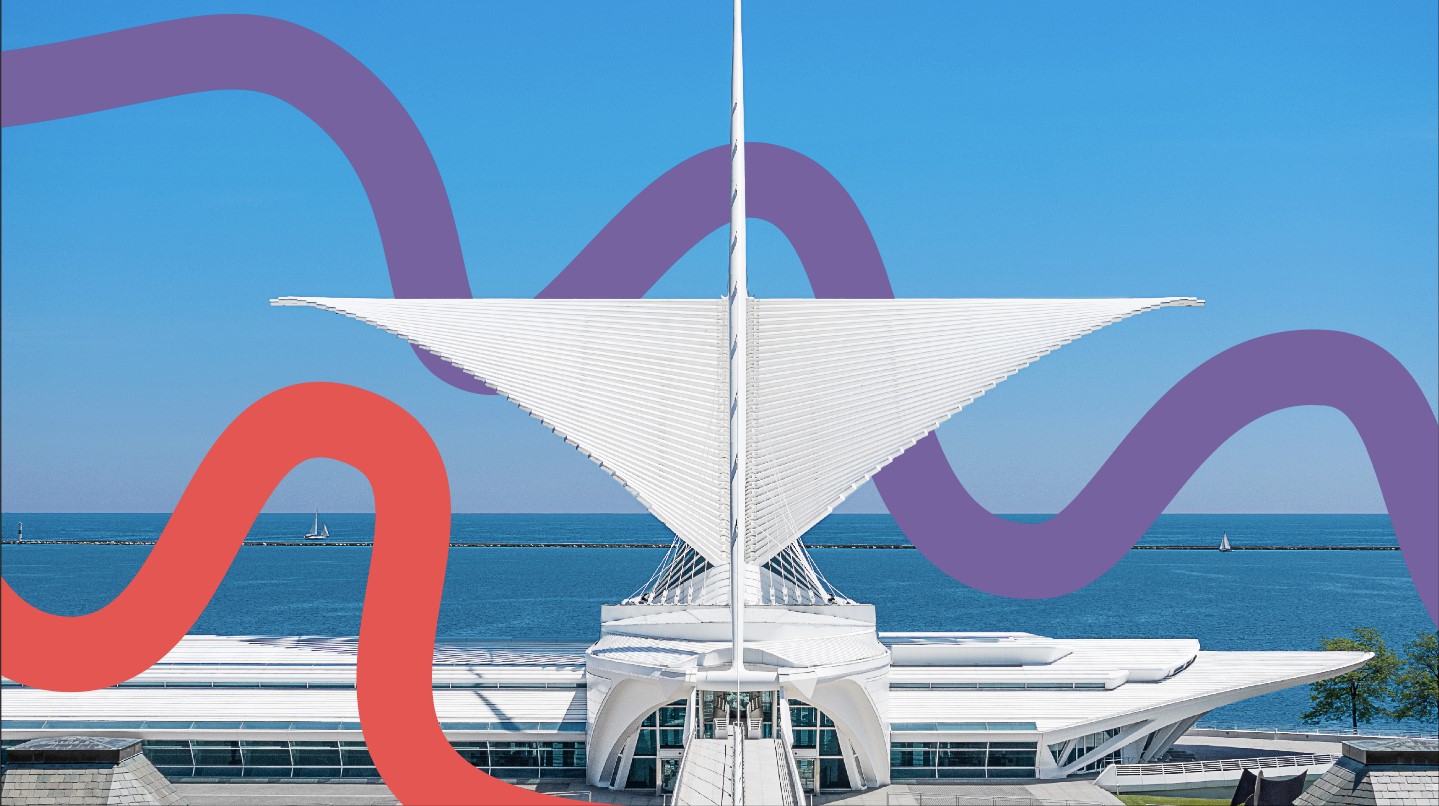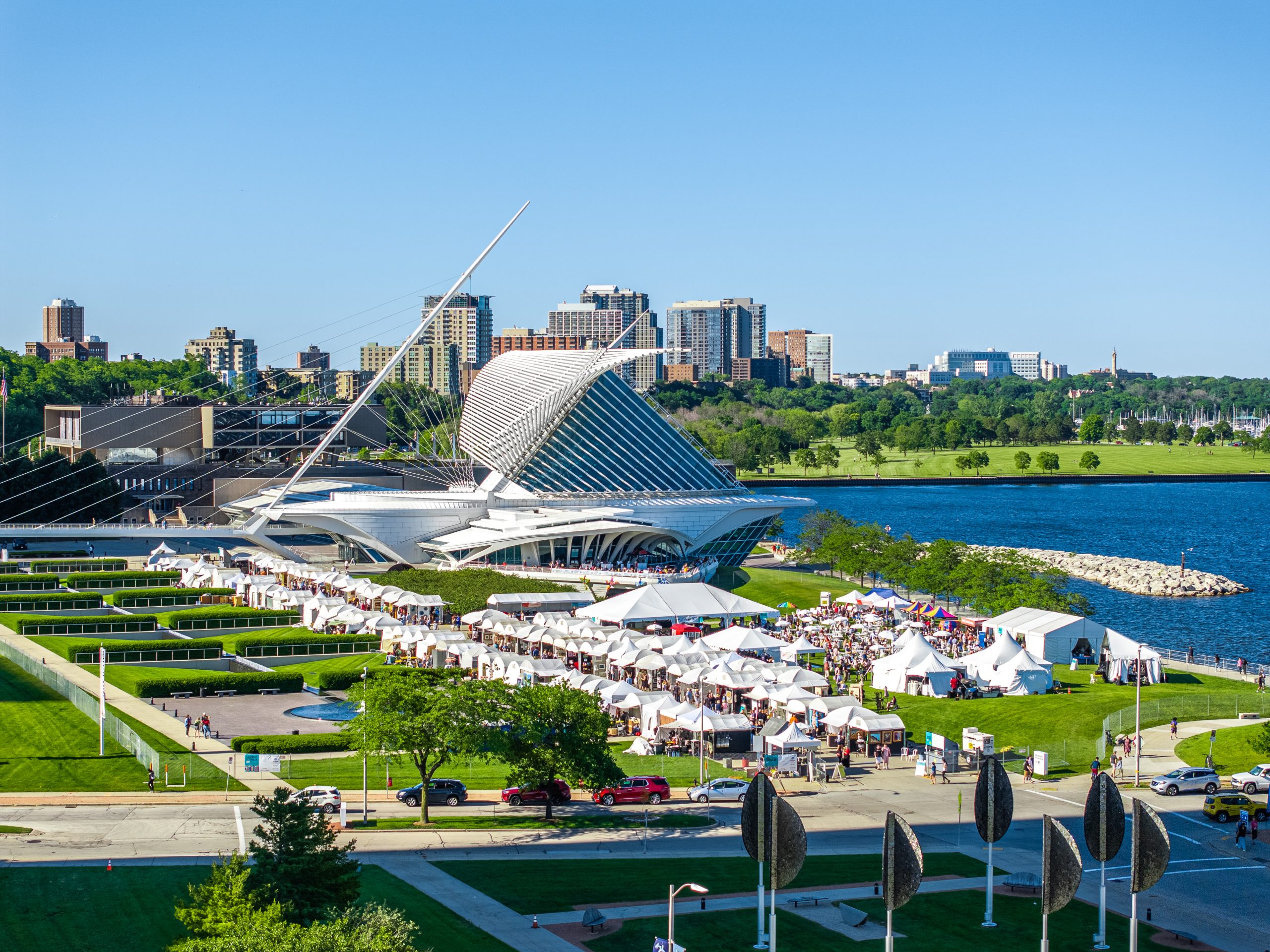Milwaukee Art Museum Commemorates 20th Anniversary of Iconic Santiago Calatrava–Designed Quadracci Pavilion
The iconic building with its movable Burke Brise Soleil “wings” overlooking Lake Michigan was dedicated in October, 2001.
Milwaukee, Wis. – October 12, 2021 – The Milwaukee Art Museum is commemorating the 20th anniversary of its acclaimed Quadracci Pavilion addition, designed by internationally recognized architect Santiago Calatrava. Since the building’s construction and dedication in 2001, the movable Burke Brise Soleil (or “wings”) that tops the cathedral-like glass ceiling of Windhover Hall has become an iconic symbol of Milwaukee, drawing visitors from around the world to the Museum and the city.
“The ‘building with the wings’ or ‘the Calatrava’ is, I’m certain, how many of us hear people refer to the Milwaukee Art Museum,” said Marcelle Polednik, PhD, Donna and Donald Baumgartner Director, Milwaukee Art Museum. “The Quadracci Pavilion is an incredible work of art itself that evokes awe, and the community has embraced it as a focal point for the city in the past two decades. It truly is a special place that offers sweeping views of Lake Michigan, with much more great art inside—a space for the community to gather, where people can find connection and inspiration.”
The Quadracci Pavilion dynamically and significantly expanded the Museum’s footprint with the addition of a main exhibition space, the Baker/Rowland Galleries, and gathering spaces for large-scale events, including weddings and corporate events. Above these spaces stands a 90-foot-high glass-walled reception hall topped by the Burke Brise Soleil and a 217-foot-wide sunscreen that can be raised. The Reiman Pedestrian Bridge reaches across Lincoln Memorial Drive, directly connecting the Museum to downtown Milwaukee. In 2001, Time magazine selected the expansion as the best new design project of the year, and USA Today selected it as one of the five most important buildings of the 21st century. The building has also played a prominent role in popular culture as a filming site for Transformers 3: Dark of the Moon, American Idol, and numerous commercials and media appearances.
At the time of the opening in 2001, then-Milwaukee Art Museum Board President Donald Baumgartner emphasized that the end result of the expansion was yet to be realized. “We have just begun to see how the Quadracci Pavilion has put Milwaukee on the map. As MAM becomes more and more of a destination, it will continue to spark a renewed sense of pride and serve as a catalyst for Milwaukee to become a progressive cultural center. That will be a great legacy to all of those who have made our beautiful winged Museum a reality.” Over the past two decades, that dream has taken shape as the Museum has held important exhibitions and programming, become an iconic part of the Milwaukee skyline, and continues to build deeper community roots.
“The positive impact of the Museum as an institution in Milwaukee and beyond is remarkable, and our family was honored to help bring about the building of this iconic work of architecture, expanding the Museum campus and the spaces available for the community and all visitors,” said Joel Quadracci, Milwaukee Art Museum Board President, 2018-2021. “It has been incredible to see the building become a symbol for the city, and I am excited to see what comes next, for our Museum and for Milwaukee.”
Santiago Calatrava first established his reputation as a preeminent architect and engineer with a series of bridges designed for cities around the world including Barcelona, Buenos Aires, and Jerusalem. The Quadracci Pavilion design for the Milwaukee Art Museum introduced Calatrava’s elegant forms to the American cityscape, and was his first building completed in North America.
Quadracci Pavilion Fun Facts
- The world’s largest cargo jet, Antonov An-225, flew sections of the Burke Brise Soleil “wings” to the Milwaukee Airport during the construction of the Quadracci Pavilion.
- The mast holding the wings is 198 feet in length.
- The 72 fins of the “wings” are between 26 and 105 feet long, weigh 100 tons collectively, and are operable via 22 hydraulic cylinders.
- Two ultrasonic wind sensors automatically close the wings if the wind speed reaches 23 mph or greater.
- The entire building weighs 83 million pounds.
- Calatrava’s design was built by Milwaukee-based architecture firm Kahler-Slater.
- The Windhover Hall atrium contains approximately 915 separate panes of glass.
- One acre of marble from Carrera, Italy, was used for the floors.
Hours
Thu, 10 a.m.–8 p.m.
Fri–Sun, 10 a.m.–5 p.m.
General Admission Pricing
$19 Adults
$17 Students (w/ID), Seniors (65+), Military
Free for Kids 12 & under every day thanks to Kohl’s
Free to Members
Free to Wisconsin K–12 teachers with valid school ID or pay stub
About the Milwaukee Art Museum
The Milwaukee Art Museum welcomes people from throughout the community and the world to find themselves and lose themselves in art, creativity and culture. At any one time, visitors can experience over 2,500 works on view within the Museum’s collection galleries and three ever-changing exhibition spaces; participate in engaging programming; and explore the one-of-a-kind spaces across the 24-acre lakefront campus. The iconic architecture brings together structures designed by Eero Saarinen, David Kahler and Santiago Calatrava. Famous for its moving Burke Brise Soleil, the Museum serves as a symbol for Milwaukee pride and connects the shores of Lake Michigan to the city’s bustling downtown.
NOTE: This press release was submitted to Urban Milwaukee and was not written by an Urban Milwaukee writer. While it is believed to be reliable, Urban Milwaukee does not guarantee its accuracy or completeness.
Mentioned in This Press Release
Recent Press Releases by Milwaukee Art Museum
Milwaukee Art Museum Presents “The Bradley Collection of Modern Art: A Bold Vision for Milwaukee”
May 28th, 2025 by Milwaukee Art MuseumThe exhibition celebrates the 50th anniversary of this transformational gift of modern art and its long-lasting legacy at the Museum and in Milwaukee.
Milwaukee Art Museum Launches Bold New Campaign to Invite Visitors to “Be Here”
May 22nd, 2025 by Milwaukee Art MuseumBold visuals, motion-driven storytelling, and a renewed call to connect through art define the Museum’s new direction.
Celebrate 60 Years of Art, Music, Food, and Fun at Lakefront Festival of Art
Apr 22nd, 2025 by Milwaukee Art MuseumGather with artists, performers, local vendors, and fellow arts and culture enthusiasts this June 13–15 at the longstanding fan-favorite lakeside festival.























